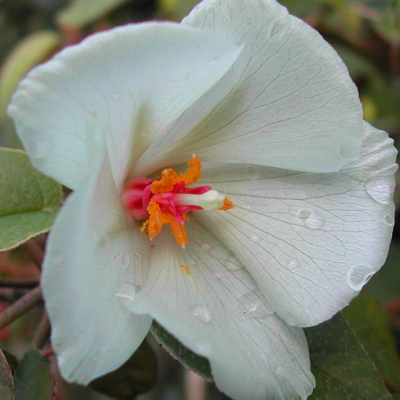St. Helena Ebony Germinating the seeds
Plant your seeds promptly for best germination
Getting started -- The seeds have hard coat that needs to be softened. To do this, scrape all sides of the seeds a few times over sandpaper or a nail file, then soak them in a cup of water for 2-3 days (not more than 4 days). Use small containers or cups that have drainage holes. For soil, use a well draining soil mix, such as 3 parts potting soil to 2 parts perlite or coarse sand. An alternate mix is equal parts of perlite and coir fiber, with some slow-release fertilizer mixed in. Fill each container with soil, but don't pack it down - just water it until evenly moist. Place a seed on top, cover with 1/4 inch (5 mm) of soil, and water the top soil layer. Until the seeds sprout, ensure that the soil surface stays moist (but not soggy). If you enclose the pots in a plastic dome or bag to maintain moisture, leave it open slightly to allow fresh air in, to prevent stem rot later on. Keep the pots between 65-75 degrees F (18-24°C), and a few degrees lower at night. Avoid letting them get above 77°F (25°C) for prolonged periods. I recommend placing a minimum/maximum thermometer near the pots to ensure they stay at the right temperature. The seeds should begin sprouting some time between 8 to 16 weeks, and continue for another 2-3 months. Once they sprout, give them bright light, but avoid strong sunlight the first 2 months. A fluorescent or LED bulb kept 3 inches (7 cm) above the plants provides the right amount of light the first month. After that, you may give them some morning sun, and increase the sun gradually each week. I recommend growing them indoors the first few months. Watering - Keep the soil evenly moist most of the time - but not soggy. Don't let the pots dry out, and don't let them sit in a tray of water. Repotting - When the plants are 2-3 months old, transplant them to a larger container. Transplant carefully to avoid letting the soil ball break apart, which can damage the roots. Watering the soil before repotting will help avoid this. For the first week after repotting, give no direct sun. Feeding - For the first 2 months i recommend giving weekly feedings with liquid fertilizer at a diluted dose (about 1/4 to 1/8 strength). Hydroponic fertilizer is ideal for young seedlings, because it complete and easily absorbed. Once they are 2 months old, you may switch to a granular fertilizer. Use a general-purpose fertilizer that contains micronutrients, and follow the dosage on the package. The plant has average fertilize requirements. Climate - The temperature on their island is mild all year, rarely getting above 85° F (29°C). It's possible that the plant may not thrive if the temperature consistently gets above 85 degrees, particularly if nights are warm. It tolerates winter temperatures in the 30s (2°C), but i don't know if it can take more than a light frost. I recommend protecting it from frost. In warmer climates, give the plants afternoon shade, and don't place them near a wall where heat can collect. Keep the pot shaded to avoid overheating the roots in hot climates, and mulch heavily to keep the soil cool & moist. Over about 40% humidity is best. Indoors, if the humidity gets too low, you may use an ultrasonic room humidifier, which you can get from thrift stores or home improvement stores. Pests to watch for - Look for any insects that affect your other plants. Be careful when choosing chemical remedies, as some may harm the plant. If you have any questions, feel free to email me. Have fun growing them! - Jeff Strange Wonderful Things
|
|||||||||


